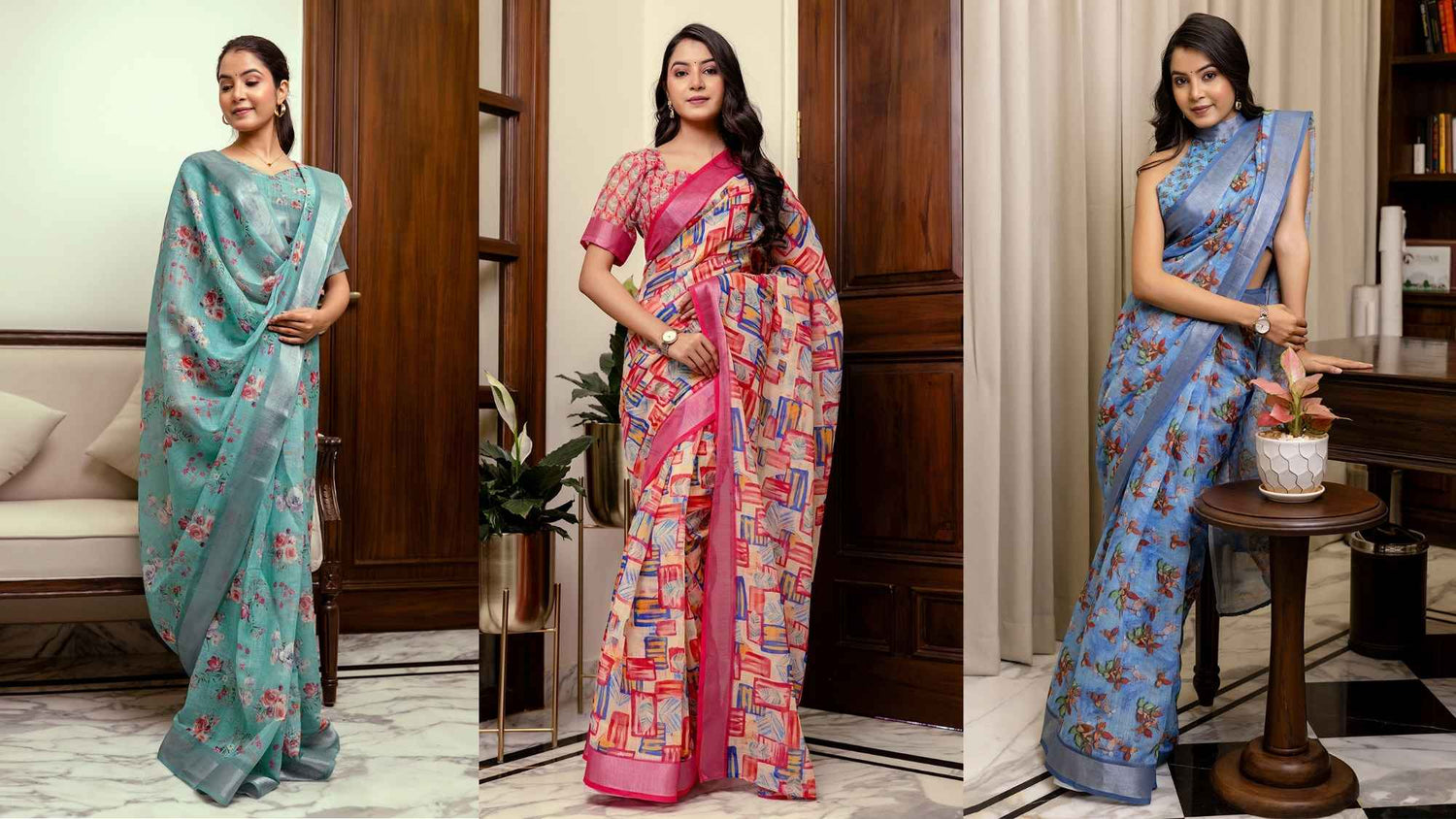Kanjivaram sarees, also known as Kanchipuram sarees, are the type of elegance and tradition in Indian fashion. Originating from the town of Kanchipuram in Tamil Nadu, these sarees are a symbol of rich cultural heritage and are often considered the "Queen of Sarees."
Woven with perfection and adorned with difficult designs, Kanjivaram sarees have a special place in the hearts of saree lovers across the globe. Whether it's a wedding, festival, or any other special occasion, draping a Kanjivaram saree instantly adds a touch of grace and sophistication.
The Weaving Process
The weaving process of a Pure Kanjivaram saree is difficult and time-consuming, often taking several weeks to complete a single saree. The process begins with the selection of high-quality mulberry silk, which is then dyed using natural colours. The silk threads are soaked in rice water and dried in the sun to enhance their strength and shine.
The saree is woven on a traditional handloom, with the weaver carefully interlocking the silk threads to create the desired pattern. One of the distinguishing features of Kanjivaram sarees is the use of the korvai technique, where the border and body of the saree are woven separately and then interlocked, giving the saree a typical look. The pallu, or the end piece of the saree, is often woven with mixed up motifs and zari work, adding to its brilliance.
Designs and Motifs
Kanjivaram sarees are known for their vibrant colours and twisted designs, which are often inspired by nature, mythology, and temple architecture. Traditional motifs such as peacocks, elephants and flowers are commonly seen on Kanjivaram sarees. The borders and pallus are often adorned with mixed up zari work, made from pure gold or silver threads, which adds a touch of luxuriance to the saree.
One of the most popular designs is the checks pattern, also known as the "kattam," which gives the saree a timeless appeal. Other popular designs include the "butta" or small motifs, "mayil" or peacock design, and the "rudraksha" pattern, which is inspired by the holy rudraksha beads. The designs are often symbolic, representing different features of Indian culture and spirituality.
Types of Kanjivaram Sarees
Over the years, Kanjivaram sarees have enlarged in terms of design and style, giving rise to different types of Kanjivaram sarees. Some of the popular types include:
1) Plain Kanjivaram Sarees: These sarees feature a simple, solid-coloured body with a contrasting border and pallu. They are elegant and underrated, making them suitable for both formal and casual occasions.
2) Checks and Stripes Kanjivaram Sarees: These sarees feature bold checks or stripes on the body, with a contrasting border and pallu. They are a popular choice for festive occasions and weddings.
3) Temple Border Kanjivaram Sarees: Inspired by the temple architecture of South India, these sarees feature temple motifs on the border and pallu. They are considered highly auspicious and are often worn during religious ceremonies.
4) Traditional Butta Kanjivaram Sarees: These sarees are adorned with small, involved motifs (buttas) all over the body, with a richly decorated border and pallu. They are a popular choice for weddings and special occasions.
5) Contemporary Kanjivaram Sarees: These sarees are a modern take on the traditional Kanjivaram, featuring contemporary designs and colour combinations. They are perfect for those who want to blend tradition with modernity.
Styling Tips for Kanjivaram Sarees
Styling a Kanjivaram saree can be both fun and challenging, given its rich texture and heavy embellishments. Here are some tips to help you style your Kanjivaram saree for different occasions:
1) Blouse Selection: The blouse plays a major role in enhancing the overall look of the saree. You can pick a contrasting colour blouse to make the saree stand out, or choose a blouse with mixed up embroidery or zari work for a more traditional look. For a contemporary twist, you can pair your Kanjivaram saree with a stylish off-shoulder or boat-neck blouse.
2) Jewellery: Traditional gold jewellery is the perfect match for a Kanjivaram saree. You can choose temple jewellery, which features designs inspired by South Indian temples, or go for a more minimalistic look with delicate gold chains and earrings. If you want to add a touch of modernity, you can pair your saree with statement jewellery pieces like chunky necklaces or bold earrings.
3) Draping Style: The way you drape your Kanjivaram saree can make a significant difference in your overall appearance. You can go for the traditional Nivi drape, which is the most common style, or experiment with other styles like the Bengali drape or the Maharashtrian drape for a unique look.
4) Hairstyle: A neatly tied bun adorned with fresh flowers is a classic hairstyle that complements the traditional look of a Kanjivaram saree. For a more modern look, you can settle for soft curls or a side-swept hairstyle. Adding a maang tikka or a hair accessory can elevate your overall look.
5) Footwear: When it comes to footwear, go for something comfortable yet stylish. Traditional juttis or sandals with a slight heel are ideal for completing the look.
Unique Features of Kanjivaram Sarees
Kanjivaram sarees are renowned for their distinct characteristics, which make them stand out from other types of silk sarees. Some of these features include:
1) Vibrant Colours: Kanjivaram sarees are known for their bright and bold colour combinations. Traditional colours like red, green, and gold are commonly used, but modern Kanjivaram sarees also feature contemporary shades like pastels and neons.
2) Involved Motifs: The motifs on Kanjivaram sarees are often inspired by South Indian culture, temples, and nature. Common motifs include peacocks, mangoes, elephants, and flowers, each carefully woven into the fabric.
3) Rich Borders: The borders of Kanjivaram sarees are one of their most defining features. These borders are often wide and heavily adorned with zari work, featuring difficult patterns and designs that contrast with the body of the saree.
4) Versatility: While Kanjivaram sarees are traditionally worn for weddings and religious ceremonies, their versatility has made them popular for other occasions as well. They can be dressed up or down depending on the occasion, making them a wardrobe major.
5) Durability: Kanjivaram sarees are known for their durability, thanks to the high-quality silk and weaving techniques used. With proper care, a Kanjivaram saree can last for decades, making it a valuable investment.
Caring for Your Kanjivaram Saree
Kanjivaram sarees are a valuable investment, and proper care is essential to maintain their beauty and longevity. Here are some tips to help you take care of your Kanjivaram saree:
1) Storage: Always store your Kanjivaram saree in a cool, dry place, away from direct sunlight. Fold the saree neatly and place it in a cotton or muslin cloth to protect it from dust and moisture. Avoid hanging the saree for long periods, as this can cause the fabric to lose its shape.
2) Cleaning: It is best to dry clean your Kanjivaram saree to preserve its colour and texture. Avoid washing the saree at home, as the delicate silk and zari work can get damaged.
3) Handling: Handle your saree with care to avoid any tears. Be cautious while wearing jewellery or accessories, as they can get caught in the saree and cause damage.
4) Airing: Occasionally, take out your saree and air it in a shaded area to prevent any musty smell and to keep the fabric fresh.
Conclusion
Kanjivaram sarees known for their luxurious silk, vibrant colours, and involved designs, these sarees hold a special place in the hearts of saree enthusiasts around the world. Whether you're attending a wedding, a festival, or any other special occasion, a Kanjivaram saree can elevate your look with its unmatched grace and sophistication.
From understanding the twisted weaving process to exploring the various types and styling tips, this guide offers a complete vision into what makes Kanjivaram sarees so unique and cherished.












